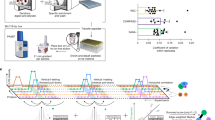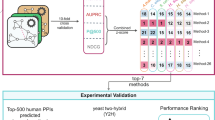Abstract
To provide accurate biological hypotheses and elucidate global properties of cellular networks, systematic identification of protein-protein interactions must meet high quality standards. We present an expanded C. elegans protein-protein interaction network, or 'interactome' map, derived from testing a matrix of ∼10,000 × ∼10,000 proteins using a highly specific, high-throughput yeast two-hybrid system. Through a new empirical quality control framework, we show that the resulting data set (Worm Interactome 2007, or WI-2007) was similar in quality to low-throughput data curated from the literature. We filtered previous interaction data sets and integrated them with WI-2007 to generate a high-confidence consolidated map (Worm Interactome version 8, or WI8). This work allowed us to estimate the size of the worm interactome at ∼116,000 interactions. Comparison with other types of functional genomic data shows the complementarity of distinct experimental approaches in predicting different functional relationships between genes or proteins.
This is a preview of subscription content, access via your institution
Access options
Subscribe to this journal
Receive 12 print issues and online access
$259.00 per year
only $21.58 per issue
Buy this article
- Purchase on Springer Link
- Instant access to full article PDF
Prices may be subject to local taxes which are calculated during checkout




Similar content being viewed by others
References
Walhout, A.J. et al. Protein interaction mapping in C. elegans using proteins involved in vulval development. Science 287, 116–122 (2000).
Giot, L. et al. A protein interaction map of Drosophila melanogaster. Science 302, 1727–1736 (2003).
Li, S. et al. A map of the interactome network of the metazoan C. elegans. Science 303, 540–543 (2004).
Stelzl, U. et al. A human protein-protein interaction network: a resource for annotating the proteome. Cell 122, 957–968 (2005).
Rual, J.F. et al. Towards a proteome-scale map of the human protein-protein interaction network. Nature 437, 1173–1178 (2005).
Davy, A. et al. A protein-protein interaction map of the Caenorhabditis elegans 26S proteasome. EMBO Rep. 2, 821–828 (2001).
Boulton, S.J. et al. Combined functional genomic maps of the C. elegans DNA damage response. Science 295, 127–131 (2002).
Reboul, J. et al. C. elegans ORFeome version 1.1: experimental verification of the genome annotation and resource for proteome-scale protein expression. Nat. Genet. 34, 35–41 (2003).
Walhout, A.J. et al. Integrating interactome, phenome, and transcriptome mapping data for the C. elegans germline. Curr. Biol. 12, 1952–1958 (2002).
Kim, J.K. et al. Functional genomic analysis of RNA interference in C. elegans. Science 308, 1164–1167 (2005).
Tewari, M. et al. Systematic interactome mapping and genetic perturbation analysis of a C. elegans TGF-β signaling network. Mol. Cell 13, 469–482 (2004).
Matthews, L.R. et al. Identification of potential interaction networks using sequence-based searches for conserved protein-protein interactions or “interologs.” Genome Res. 11, 2120–2126 (2001).
Venkatesan, K. et al. An empirical framework for binary interactome mapping. Nat. Methods advance online publication, doi:10.1038/nmeth.1280 (7 December 2008).
Hunt-Newbury, R. et al. High-throughput in vivo analysis of gene expression in Caenorhabditis elegans. PLoS Biol. 5, e237 (2007).
Dupuy, D. et al. Genome-scale analysis of in vivo spatiotemporal promoter activity in Caenorhabditis elegans. Nat. Biotechnol. 25, 663–668 (2007).
Kao, H.L. & Gunsalus, K.C. Browsing multidimensional molecular networks with the generic network browser (N-Browse). Curr. Protoc. Bioinformatics Ch. 9, Unit 9 11 (2008).
Hu, Z., Mellor, J., Wu, J. & DeLisi, C. VisANT: an online visualization and analysis tool for biological interaction data. BMC Bioinformatics 5, 17 (2004).
Motegi, F., Velarde, N.V., Piano, F. & Sugimoto, A. Two phases of astral microtubule activity during cytokinesis in C. elegans embryos. Dev. Cell 10, 509–520 (2006).
Branda, C.S. & Stern, M.J. Mechanisms controlling sex myoblast migration in Caenorhabditis elegans hermaphrodites. Dev. Biol. 226, 137–151 (2000).
Wolf, F.W., Hung, M.S., Wightman, B., Way, J. & Garriga, G. vab-8 is a key regulator of posteriorly directed migrations in C. elegans and encodes a novel protein with kinesin motor similarity. Neuron 20, 655–666 (1998).
Schlaitz, A.L. et al. The C. elegans RSA complex localizes protein phosphatase 2A to centrosomes and regulates mitotic spindle assembly. Cell 128, 115–127 (2007).
Gunsalus, K.C. et al. Predictive models of molecular machines involved in Caenorhabditis elegans early embryogenesis. Nature 436, 861–865 (2005).
Lee, I. et al. A single gene network accurately predicts phenotypic effects of gene perturbation in Caenorhabditis elegans. Nat. Genet. 40, 181–188 (2008).
Gunsalus, K.C., Yueh, W.C., MacMenamin, P. & Piano, F. RNAiDB and PhenoBlast: web tools for genome-wide phenotypic mapping projects. Nucleic Acids Res. 32, D406–D410 (2004).
Wilson, C.A., Kreychman, J. & Gerstein, M. Assessing annotation transfer for genomics: quantifying the relations between protein sequence, structure and function through traditional and probabilistic scores. J. Mol. Biol. 297, 233–249 (2000).
Tatusov, R.L. et al. The COG database: an updated version includes eukaryotes. BMC Bioinformatics 4, 41 (2003).
Braun, P. et al. An experimentally derived confidence score for binary protein-protein interactions. Nat. Methods advance online publication, doi:10.1038/nmeth.1281 (7 December 2008).
Boxem, M. et al. A protein domain-based interactome network for C. elegans early embryogenesis. Cell 134, 534–545 (2008).
Eyckerman, S. et al. Design and application of a cytokine-receptor-based interaction trap. Nat. Cell Biol. 3, 1114–1119 (2001).
Lemmens, I., Lievens, S., Eyckerman, S. & Tavernier, J. Reverse MAPPIT detects disruptors of protein-protein interactions in human cells. Nat. Protoc. 1, 92–97 (2006).
Lee, M.-H. & Schedl, T. RNA-binding proteins. in WormBook (ed. Blumenthal, T.) doi:10.1895/wormbook.1.7.1 (2006).
Podbilewicz, B. Cell fusion. in WormBook (eds. Kramer, J.M. & Moerman, D.G.) doi:10.1895/wormbook.1.7.1 (2006).
Acknowledgements
We thank F. Piano and members of the Cancer Center for System Biology and the Vidal laboratory for discussions, A. Petcherski from WormBase for assistance with worm genetic interactions, and Z. Hu for VisANT assistance. The worm interactome project was supported by grants from the US National Institutes of Health—R01 HG001715 (M.V. and F.P.R.), R01 HG003224 (F.P.R.), F32 HG004098 (M. Tasan), T32 CA09361 (K.V.)—a University of Ghent grant GOA12051401 (J.T.), and the Fonds Wetenschappelijk Onderzoek – Vlaanderen (FWO-V) G.0031.06 (J.T.). I.L. was supported by a postdoctoral fellowship from the FWO-V. K.C.G. and H.-L.K. were supported by US Department of the Army Award W81XWH-04-1-0307 and the State of New York's Science and Tech Resources contract C040066. M.V. is a Chercheur Qualifié Honoraire from the Fonds de la Recherche Scientifique (FRS-FNRS, French Community of Belgium).
Author information
Authors and Affiliations
Contributions
J.-F.R., N.S. and A.-R.C. coordinated experiments and data analysis. J.-F.R., T.H.-K., J.M.S., F.G., S.C., P.B., N.L., N.A.-G., E.D., D.S., A.D., C.S., M.V., H.Y., M.B., S.M., M.D., M. Tewari and J.S.A. performed the high-throughput ORF cloning and Y2H screens. I.L., A.-S.d.S., P.B. and J.T. conducted the MAPPIT experiments. N.S., A.-R.C., M. Tasan, T.H., N.K., K.V., C.F., N.B., M.A.Y., C.L., A.S., H.-L.K. and K.C.G. performed the computational analyses. M. Tasan, N.S., C.F., A.-R.C., H.-L.K. and K.C.G. adapted or built the website and visualization tools. N.S., A.-R.C., J.-F.R., M.E.C., J.V., F.P.R. and M.V. wrote the manuscript. M.V. conceived the project. D.E.H., J.T., F.P.R. and M.V. co-directed the project.
Corresponding authors
Supplementary information
Supplementary Text and Figures
Supplementary Figures 1–5, Supplementary Tables 1–5, Supplementary Discussion, Supplementary Methods (PDF 987 kb)
Supplementary Data 1
WI8 MIMIX (TXT 2857 kb)
Supplementary Data 2
Integrated functional network (TXT 7021 kb)
Rights and permissions
About this article
Cite this article
Simonis, N., Rual, JF., Carvunis, AR. et al. Empirically controlled mapping of the Caenorhabditis elegans protein-protein interactome network. Nat Methods 6, 47–54 (2009). https://doi.org/10.1038/nmeth.1279
Received:
Accepted:
Published:
Issue Date:
DOI: https://doi.org/10.1038/nmeth.1279
This article is cited by
-
Altered blood gene expression in the obesity-related type 2 diabetes cluster may be causally involved in lipid metabolism: a Mendelian randomisation study
Diabetologia (2023)
-
Identifying accurate link predictors based on assortativity of complex networks
Scientific Reports (2022)
-
Percolation on feature-enriched interconnected systems
Nature Communications (2021)
-
Trauma-induced regulation of VHP-1 modulates the cellular response to mechanical stress
Nature Communications (2021)
-
The tapeworm interactome: inferring confidence scored protein-protein interactions from the proteome of Hymenolepis microstoma
BMC Genomics (2020)



